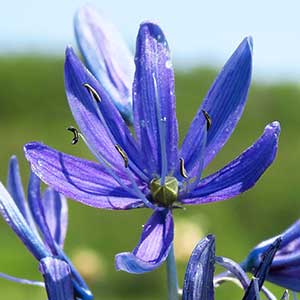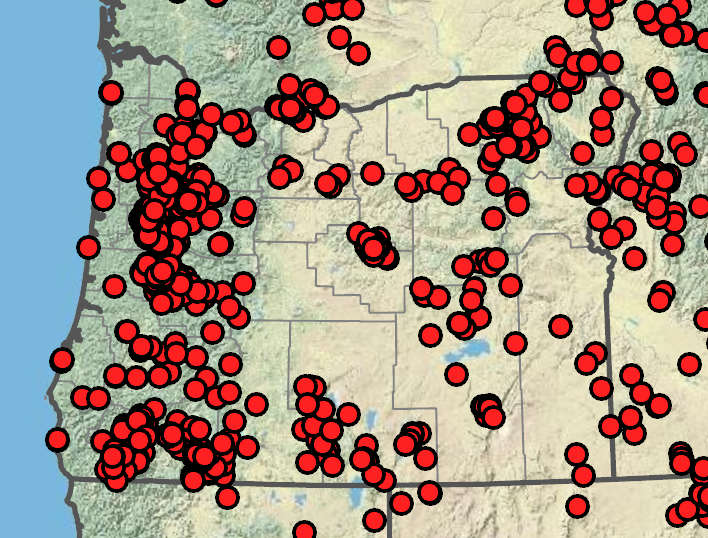Camassia quamash
Camassia leichtlinii
common camas
great camas, Leichtlin's camas
3–5, lanceolate to linear, 25–70 cm × 5–15 mm.
4–8(9), lanceolate, 20–70 cm × 5–30 mm.
nodes 3–45, with 2–5 or more flowers open at once, sterile bracts 0–2; most longer than pedicels, tan to blue;
pedicel-stem angle broad or less often narrow.
6–60-flowered, often only 1–4 flowers open at a time, sterile bracts 0–3(5); most equal or shorter than pedicels, tan to pale green;
pedicels spreading, forming broad angle with stem.
corollas bilateral, rarely radial;
tepals 10–35 × 3–5 mm, pale blue to deep blue-violet, initially withering individually or connivently but separating in fruit and persisting on stem;
veins 3–9.
corollas radially symmetric;
tepals 2–4 cm × 4–12 mm, blue to deep blue-purple or creamy white, withering connivently and twisting off top of fruit or deciduous from pedicels that remain on stem;
veins 5–9.
oriented away from or appressed to stem; ovoid-oblong, 15–25 mm.
oblong-ovoid, 1–3 cm × 5–15 mm; dull.
5–10 per locule.
6–12 per locule.
Camassia quamash
Camassia leichtlinii
Western North America. 8 subspecies; 6 subspecies treated in Flora.
Camassia quamash includes a confusing array of morphologically and geographically diverse subspecies. Differentiating them remains challenging, yet genetic data have revealed a detectable molecular signature between groups that grow “east” (breviflora, quamash, utahensis) and “west” of the Cascades (intermedia, maxima, walpolei). Taxa within these groups are still unresolved (Fishbein et al. 2010).
Western North America. 2 subspecies.
Subspecies suksdorfii is the most broadly distributed of the two C. leichtlinii taxa. In Douglas County, it occurs near C. l. ssp. leichtlinii but usually in separate populations. These subspecies are potentially interfertile based on a historically known site near Roseburg where a creamy-white form dominated, yet plants showed the full color range. Further population-level study is needed. The tall racemes, strictly radial symmetry, and connivently twisted, deciduous tepals distinguish C. leichtlinii from all subspecies of C. quamash. Plants in populations of C. cusickii, C. quamash ssp. breviflora, and ssp. walpolei can produce radial, near radial, or slightly bilateral flowers, but these taxa have three tepal veins in contrast to five to nine in C. leichtlinii. In Camassia, anthesis length varies, but flower buds usually open from mid-afternoon to dusk. Relative to C. quamash and C. cusickii, the mostly diurnal flowers of C. leichtlinii remain open for a shorter time, sometimes closing as early as late morning or early afternoon, leaving racemes with only buds above the withered flowers (Gould 1942).
Susan Kephart
Susan Kephart





